Photographs: Denis Balibouse/Reuters Rajiv Rao in New Delhi
If you happened to have looked up in the skies above the US at any point in the last six months, you may have spotted an odd-looking object potentially sired by the pairing of a dragonfly and an albatross that could find home in a Philip K Dick novel.
If you did a little digging around, you would learn that this mechanised beast was either an inspired stunt or a true technology breakthrough in the world of aviation-namely, the world's first solar plane, the Solar Impulse.
The Impulse has wings the size of a Boeing 747's, but a cockpit-cum-fuselage that can only accommodate one person.
The plane weighs no more than a medium-sized car-most of the weight thanks to 400 kg of lithium ion batteries which allow it to fly at night.
…
Future of flying: Solar-powered planes?
Image: Solar Impulse's Chief Executive Officer and pilot Andre Borschberg takes off with the solar-powered HB-SIA prototype aircraft during a flight from Brussels to Paris.Photographs: Francois Lenoir/Reuters
It's odyssey across the US was in several 24-hour stages with stopovers in Phoenix, Dallas-Fort Worth, St Louis, Cincinnati and Dulles.
Its last flight from Washington's Dulles airport to New York's John F Kennedy was at a painful crawl of 27 km/hr and it lasted 18 hours 23 minutes-long enough for someone to drive the same route three times over.
Yet the Impulse's flight has quickened the pulse of some percentage of the world's population because of one important aspect of the flight: it took place without burning a single drop of aviation turbine fuel.
Aviation history has a number of important landmarks, all within the last 110 years or so.
…
Future of flying: Solar-powered planes?
Image: German test pilot Markus Scherdel steers the solar-powered Solar Impulse HB-SIA prototype airplane during his first flight over Payerne.Photographs: Christian Hartmann/Reuters
In 1903, Wilbur and Orville Wright made history by orchestrating the world's first powered flight in North Carolina in the US, which showed the world that man could indeed fly.
Just thirty-six years later, the world's first jet engine took to the skies when the 838-pound-static-thrust Heinkel HeS38 turbojet engine plane, designed by German Hans von Ohain, reached a speed of 400 miles per hour and was aloft for seven minutes.
A mere nine years after that, in 1947, the US Air Force test pilot Chuck Yeager created the world's first sonic boom by flying faster than the speed of sound-or Mach 1-in a rocket-powered Bell X-1 over Muroc Dry Lake in California.
Does the Impulse deserve to be mentioned in the same breath?
…
Future of flying: Solar-powered planes?
Image: Solar Impulse's Chief Executive Officer and pilot Andre Borschberg performs a low altitude go-round procedure with the solar-powered HB-SIA prototype aircraft during a test flight at Payerne airport.Photographs: Denis Balibouse/Reuters
It all depends on whether this plane is the progenitor of what will soon become a ubiquitous way of travel.
The big question then is if the math adds up - in other words, if solar power really has the capability to transport us across the skies in the near or distant future.
David Mackay's book Sustainable Energy-Without the Hot Air and the website empiricalzeal.com have done some helpful math to try and figure this out.
The Impulse has 11,628 solar cells embedded on its wings, which roughly cover 200 sq metres. Since we on earth can suck 250 watts/sq metre directly from the sun, this allows the panels to produce 50,000 watts of power.
…
Future of flying: Solar-powered planes?
Photographs: Courtesy, Solar Impulse
The problem is, solar panels are not the most efficient power generators - ranging from 10-20 per cent in efficiency, depending on the panels.
Apparently, the Impulse functions at 12 per cent, which then translates into 6,000 watts to propel the plane, which is just enough for the light craft to fly at a trundling speed.
Now, the Impulse weighs 2 tonnes and a passenger plane such as the Airbus 380 weighs 560 tonnes.
So, even if solar panels achieve double the efficiency at some point, you will not have enough power to even rev up an Airbus's jet engines, let alone take to the skies in one.
…
Future of flying: Solar-powered planes?
Image: German test pilot Markus Scherdel steers the solar-powered Solar Impulse HB-SIA prototype airplane during his first flight over PayernePhotographs: Reuters
Then, there is the vexing issue of night flight, which the Impulse undertakes using its lithium polymer batteries that can just about keep its engines-as powerful as a motorised scooter-running.
This makes nocturnal voyages limited to a range of not more than a 1,000 km.
The possibility of solar becoming a flight fuel becomes even more remote when you consider most domestic aircraft now average 0.5 miles per gallon of jet fuel-a remarkable 40 per cent improvement since 2000 (International jets have also improved but not at the same rate).
Plus, in 2011, United's Boeing 737-800 used a 40-60 blend of petroleum-based jet fuel and biofuel made from algal oil to fly from New Jersey to Paris, thereby slashing its emissions by 80 per cent.
Many more airlines have been experimenting with alternative fuels since then (but the industry is still evaluating how cost-efficient the new fuels are considering how expensive an algal biofuel plant costs to build).
Future of flying: Solar-powered planes?
Image: Solar Impulse pilot Andre Borschberg speaks to members of the media before fellow pilot Bertrand Piccard takes off from Moffett Field to begin the first leg of their 2013 Across America Mission in Mountain View, California.Photographs: Stephen Lam/Reuters
Plus, engine technology such as using more heat resilient ceramics and increasing engine efficiency using geared turbofans is also trying to push the envelope on cheaper, greener air travel.
However, that's not to completely dismiss solar outright from being the future of flight. After all, the world has constantly witnessed game changers-such as jet engines-that have upended how and at what price we do things.
Perhaps solar panel technology will go through a revolution (it will have to be a mind-bending one) or maybe battery technology will finally come into its own.
Until then though solar travel-while poignantly demonstrating the power of clean energy via the Impulse-will still be something out of an Isaac Asimov novel rather than a tantalising reality.
...

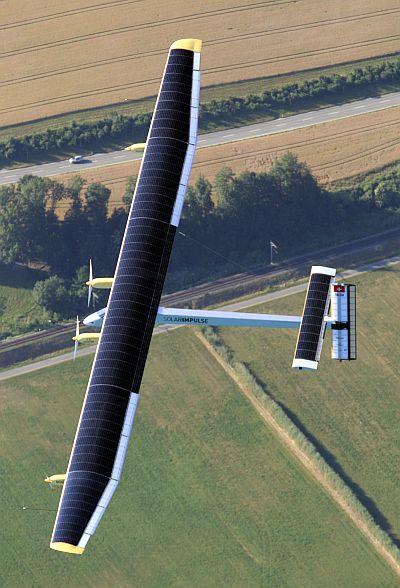
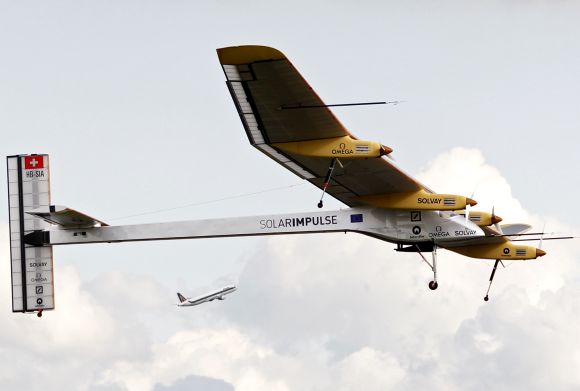
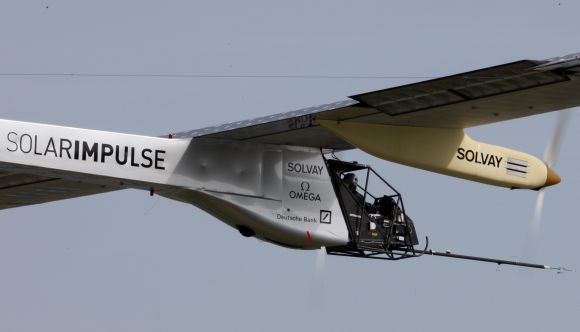
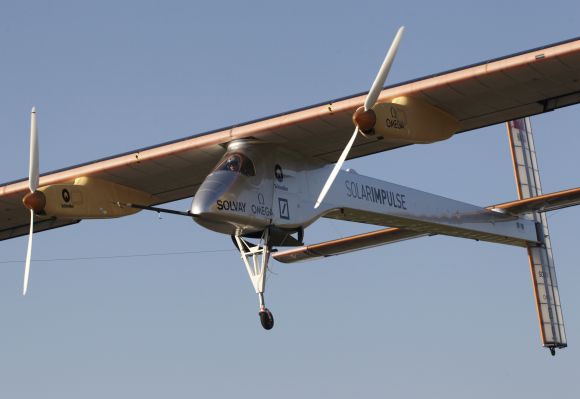
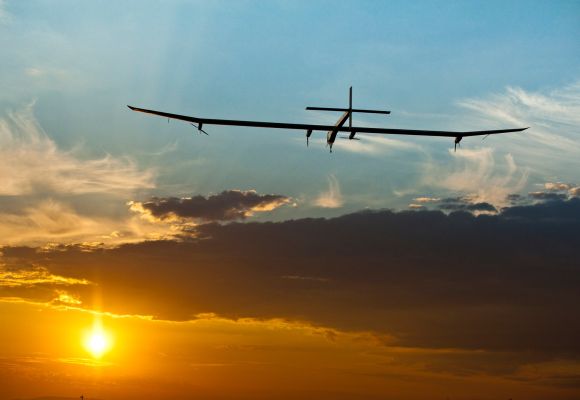
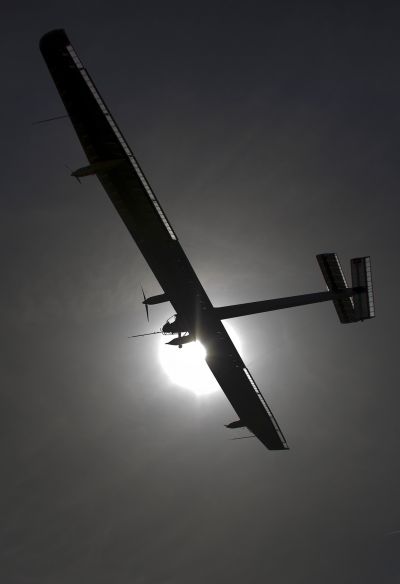


article